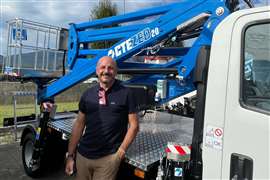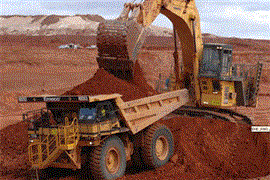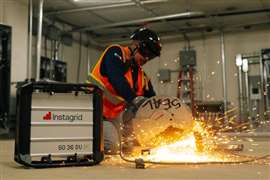Van and pick-up mounts: Why change is a good thing
15 May 2023
How the pick-up and van mounted sectors have close synergies and they are being propelled by the same needs.
There has been continued development in the sector. Co.me.t has reignited its van mount line specifically to move into the major UK and France markets.
The HVM (Hydraulic Van Mounted) line models include the 10m working height HVM 10 for small vans, the 12m HVM 12 on vans from 3.5 tonne GVW, with or without outriggers and the 14m HVM 14 that can be installed on vans from 3.5 tonnes GVW upwards.
They are all customizable and installable on commercial vehicles, and diesel or electric vehicles. Last but not least, there is a 46 KV insulated version for working with electricity lines.
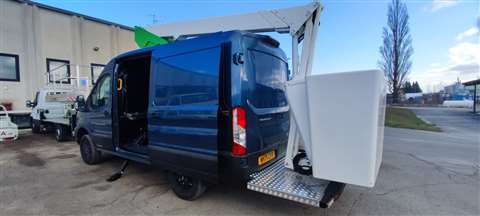 Comet HVM 15 van mount (PHOTO: Comet Officine)
Comet HVM 15 van mount (PHOTO: Comet Officine)
The company is also a specialist in the pick-up platform market and has a unique range with 14m and 16m models with a jib. The latest is the low to ground Eurosky 16 recently launched on an Isuzu D Max Pick up, Toyota Hilux and Ford Ranger.
”We are pushing pick up vehicles a lot because they represent a good alternative to the 4x4 vehicle,” said Gabriele Valli, sales director at Co.me.t.
Back onto the subject of van mounts, Co.me.t has produced this product type in the past and a few years ago sold 700 units in Iraq. Now it is broadening its sights with three new models.
The company says it has embraced simplicity by producing 100% hydraulic equipment. “We have eliminated all the unnecessary electronic components to have simple equipment,” says Valli.
“Of course, with automatic stabilization from the cab and everything required. So the strong point is that to have reliable equipment that does not create problems.”
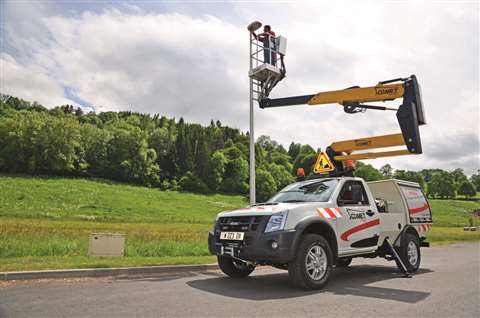 Comet has long experience in the pick-up mount sector. (PHOTO: Comet)
Comet has long experience in the pick-up mount sector. (PHOTO: Comet)
Looking to the future, Gabriele Valli, sales director at Co.me.t said, “Although all the competitors try to find new channels, these products are predominant in France and the UK.
“We don’t see big developments in numbers in other countries like Italy, for example, except Northern Europe, particularly Scandinavia. The traditional platform on chassis is always the most requested.”
The compromise between articulated and telescopic aerial platforms
Of course the van mount and pick-up mounted products have a close synergy. As GSR says articulated machines are often prefered for their compactness but some users prefer a pick up so that they can keep a telesopic boom and fly jib. An example is the E142TJV which, with its 14.1m working height and 250kg basket capacity, combines these characteristics.
This segment is seeing some innovations and we will soon see a couple of new TJVs on vans and pick-ups with a further increase in outreach and compactness.
Articulated machines on pick-ups however remain popular, like the E140P which started life in 2014 on the Piaggio Porter micro vehicle, which is no longer in production, and then the modern pick-up from 3 tonnes upwards.
The E140P now sits on a 3.2 tonne Ford Ranger with a good payload and 13.2m working height and 250kg basket capacity.
“It is difficult to say whether in the future GSR will sell more or less E140P or TJV on pick-ups compared to the corresponding van mounted equipment.
“Our current production of pick-up and vans is one to three and we don’t expect it to change much through 2024.”
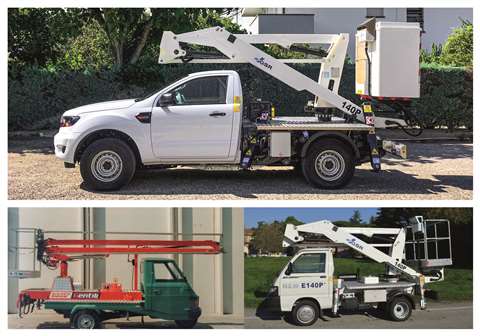 How the GSR 140P has evolved over the years. (PHOTO: GSR)
How the GSR 140P has evolved over the years. (PHOTO: GSR)
The market has a great potential and is diversifying, according to GSR, yet the opportunities also throw up some challenges. “Let’s try to be ready even if the European push towards electricity shows some critical issues regarding the performance of vehicles, infrastructures and what is happening in the rest of the world.”
This is all combined with demands for lightness, reusability but without forgetting the running economy.
“These are technical requirements that we have been working on for years but the most difficult part to imagine will be to quickly change the way we have made and used things up to now.”
As GSR has pointed out, while pick-up mounts offer real alternatives, the van mount still dominates. Versalift VTE-34-125, mounted on a Renault Master, is the manufacturer’s latest development in the van mounted platform.
Also known as the EVO 2, when mounted on an L2H2 Renault Master, it has 615kg of spare payload, leaving 400kg of payload when fuel, driver and passengers are included.
How effective teamwork can lead to successful product design
As the company says, the close working alignment between Versalift’s Danish and French teams – with the France contingency represented by France Élévateur since Versalift aquired the manufacturer last year - has created a product that offers more outreach, increased working height, better payload and an overall better working at height.
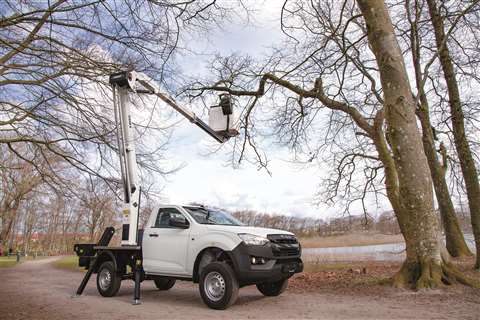 Versalift’s VTA-38-135-H for the European market. (PHOTO: Versalift)
Versalift’s VTA-38-135-H for the European market. (PHOTO: Versalift)
The VTA was launched for the UK market in 2021 with great success. Due to the high demand in the UK, it is now being launched it as an EU model as well. The TVE and TVTE as well as the 100% electric VTL-145-F are all being launched in the spring of 2023.
Versalift’s latest pick-up is the VTA-135-H on Isuzu, while van mounts are represented by the VTE-125 and VDTE-120 on Renault Master.
The new VTE incorporates Versalift’s high-strength steel structure and profiled boom which has been used extensively on van and truck mount platforms since 2018 – along with the all-aluminium fly boom making it the lightest platform Versalift has ever produced in this range.
The pedestal, subframe and rear step have also been designed with weight optimisation in mind.
The VTE-125 has a unique working diagram due to there being no boom limit system, therefore giving the platform a full working diagram.
Featuring a fixed fly jib and telescopic upper boom, the VTE-125 has a working height of 12.3m, an outreach of 7m, a 120kg safe working load platform capacity, and a bucket capacity of 120kg. The VTE is stable on a 3°/5° slope and is stability tested to BS: EN280 - 150% overload standard for stability.
An extra benefit of the VTE’s new pedestal and subframe design is the van has a completely flat floor and therefore an unprecedentedly spacious cargo room – good for storage of tools and racking
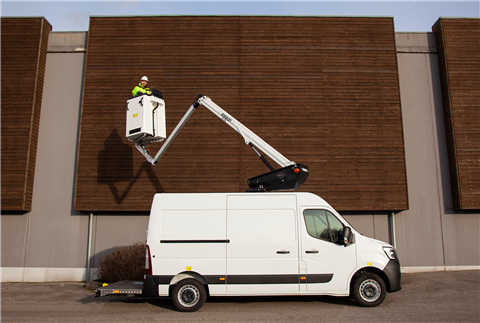 The Versalift VTA-34-135. (PHOTO: Versalift)
The Versalift VTA-34-135. (PHOTO: Versalift)
As standard, the VTE comes with an electric motor/pump for the hydraulic system, which has been integrated into the pedestal – allowing for more room in the back of the van.
The electric motor/pump is ideal for electric vehicles, with or without an E-PTO – this is due to the platform being so light that there is spare payload available to install an additional battery pack allowing the operator to run the hydraulics on the electric vans without the E-PTO.
How manufacturers are lowering the weight of mounted aerial platforms
The UPTO is France Élévateur’s brand new range. The innovations make it the manufacturer’s most complete model.
The company says its unique design represents a new generation of aerial platforms. Work was carried out to reduce the weight of the structure and energy consumption in preparation for a future with low emission vehicles that can bare large payloads.
As the first model in the line, the 15m working height UPTO15 will be followed by several other models from 12m to 18m on van and chassis cab.
There is a weight reduction of 30% compared to the previous range and 10% compared to the top-level units in the market today, says the company. On the same end, the innovative control system technology consumes up to 20% less electricity.
The UPTO 15 has a maximum outreach of 9.10m and is mounted on a 3.5 tonne van and can work at on a 15% ramp and 5% cant.
It is equipped with outreach proportional load in the basket load cell for measuring the real weight in basket and a 180° fly jib, 2 x 60° basket rotation and a basket load of 230kg for two persons. Turret rotation is 400°.
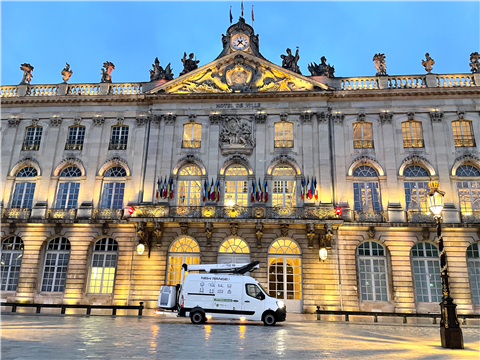 The UPTO15 from France Élévateur. (PHOTO: France Élévateur)
The UPTO15 from France Élévateur. (PHOTO: France Élévateur)
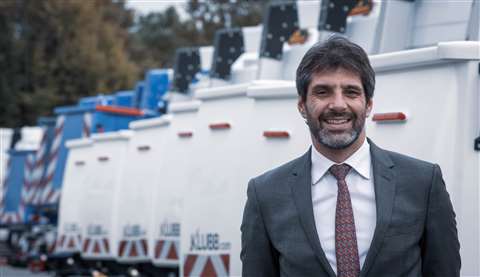 Henri Bourrellis, international development director at Klubb Group. (PHOTO: Klubb)
Henri Bourrellis, international development director at Klubb Group. (PHOTO: Klubb)
Klubb extends Isoli tie-in
Klubb Group has continued to consolidate its position with Isoli since the French manufacturer acquired Italy-based Isoli last year.
This year Klubb announced that its dealer for the Netherlands, Kraan-en Truck Service (K.T.S.) will also take on the Isoli product range. The deal sees K.T.S. end its former distribution agreement with CTE.
Henri Bourrellis, international development director of Klubb Group, said, “After seven years of partnership between the Klubb Group and K.T.S., and in addition to the good relationship and success we have developed, it is obvious that K.T.S. becomes the distributor of Isoli range in The Netherlands.”
Jan van den Berg, at K.T.S. added, “We are very happy to start working with Isoli. Over the last few months since Bauma we have carefully checked and tested the quality of Isoli products.
“The Klubb Group has an aggressive plan to develop new machines over the next year and clearly, it was an advantage for us to be part of this adventure.”
STAY CONNECTED



Receive the information you need when you need it through our world-leading magazines, newsletters and daily briefings.
CONNECT WITH THE TEAM










